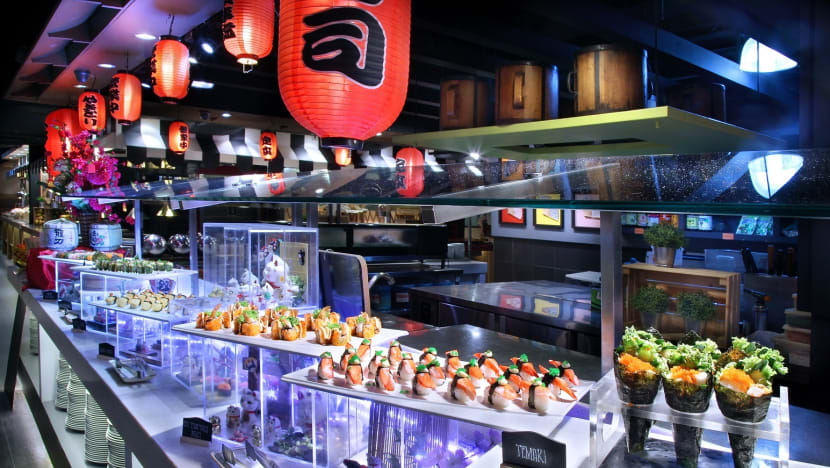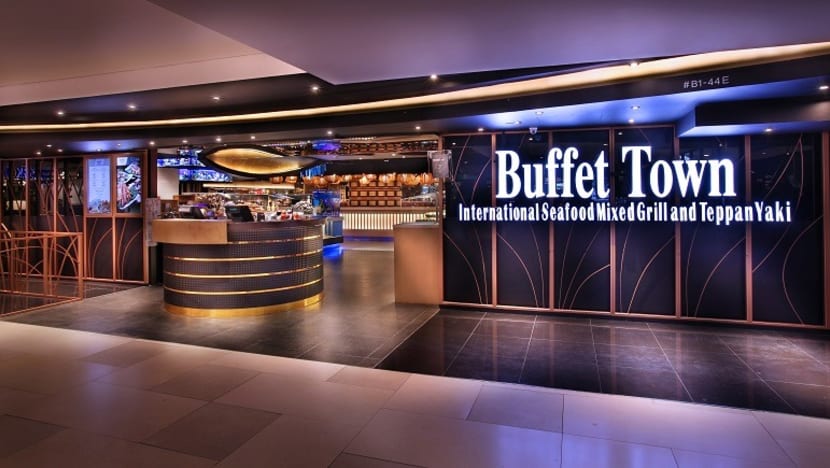'It’s not sustainable': Buffet restaurants struggling with COVID-19 measures

Buffet Town at Raffles City shopping centre said seating capacity has been reduced by 50 per cent due to safe management measures. (Photo: Minor Food Group)
SINGAPORE: While buffet lines have resumed, restaurants have been finding it difficult to continue business as usual, due to strict and evolving COVID-19 guidelines.
The constant state of flux of safe management measures has pushed some to throw in the towel and go a la carte instead.
On Thursday (Aug 19), Korean barbecue restaurant chain Seoul Garden announced that it was pivoting from its buffet concept - which lasted for more than three decades - to an “all-new a la carte menu”.
The decision, the group said, was “in response” to the challenges faced by the industry over the past one-and-a-half years as well as the country’s move towards an endemic COVID-19 strategy.
“Changes to the (COVID-19) rules have understandably needed to be frequent in response to a climate of uncertainty in face of clusters in the community,” the press release said.
“Seoul Garden’s decision to pivot its dining concept aims to answer this call and was an important consideration in the Group’s adoption of an a la carte dining experience.”
Under revised COVID-19 safety guidelines for food lines and buffets, diners are not allowed to help themselves to the spread. Instead, servers will have to dish it out for them and ensure that diners do not come into contact with the food.
It has piled on more pressure for buffet restaurant operators, who have already been bruised and battered by the pandemic. Some have had to bring in additional manpower to cope with the rules, resulting in higher costs.
Outlet manager of Captain Kim Korean BBQ & Hotpot Buffet JC Cheah told CNA that the restaurant has had to hire three more waiters since April, after the government eased restrictions to allow buffet lines.
Meanwhile, Minor Food Group, which operates Kiseki Japanese Buffet Restaurant at Orchard Central and Buffet Town at Raffles City shopping centre, shared that manpower costs have increased by up to 30 per cent as the group has had to hire more employees to cope with the new rules.
“We have to serve tables dish by dish so we need an army of service staff nowadays who just waiting for (customers) to pick the order on the iPad, and once the order comes in, we have to serve it - even if it’s just one cup of coffee,” said the group’s chairman and CEO Dellen Soh.

It is a similar case at popular buffet eatery Carousel at Royal Plaza on Scotts, which has increased manpower by about 30 per cent.
This is to help with serving at the counters, managing of social distancing measures, frequent sanitising of the counters and verifying of vaccination certification, said Mr Patrick Fiat, general manager of Royal Plaza on Scotts.
BUFFETS ARE A "NUMBER GAME"
But with the buffet restaurants currently operating at half capacity due to safe distancing measures, Mr Soh said it is not sustainable in the long run.
"Buffets are all about numbers and we need more customer volume in order to survive ... it’s not sustainable, because right now we can only do 230 customers, whereas in the past we could sit 450 customers," he said.
"The reason why we are still surviving is because we are very fortunate to have our landlords’ support to keep these business going, and they are providing rental relief."
Despite this, buffet operators CNA spoke to said going fully a la carte may not be an option, as they could lose existing customers.
“Our focus is on buffets and if we change to a la carte, I don’t think customers will come because we have tried to offer a la carte options in other outlets, but the feedback was not very good, we probably sold only one set per day,” said Mr Cheah.
“To be honest, we only rolled out the a la carte option because we just wanted to fill in the tables, even if we don’t do anything, business is still bad,” he added.
Carousel said that its guests have also provided feedback that they would prefer seeing a buffet spread for the dining experience as compared to a la carte dining.
As for Buffet Town and Kiseki, which have huge floor areas of between 8000 and 15,000 sq ft, their options are limited.

“If the size of the buffet restaurants was only 2000 sq ft, I could have easily converted it (into an a la carte restaurant) and done it a long time ago but because of their sheer size, it’s just not possible,” said Mr Soh.
“It would require an enormous amount of (capital expenditure) and investment to do that ... I would need to spend at least a million (dollars) just to convert them into a restaurant and then it may not even help, because you have to think about what kind of food you want to sell in such a big space.”
He added: "Our only hope is that we can hang in there, and we hope that more measures will be lifted so that we can actually get back on our feet to run a proper buffet restaurant."
BOOKMARK THIS: Our comprehensive coverage of the COVID-19 pandemic and its developments
Download our app or subscribe to our Telegram channel for the latest updates on the coronavirus pandemic: https://cna.asia/telegram















